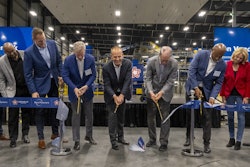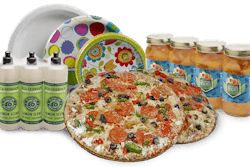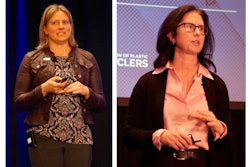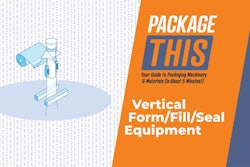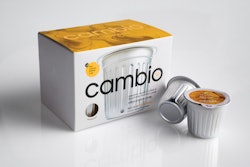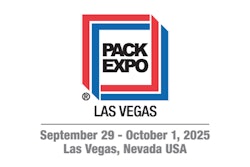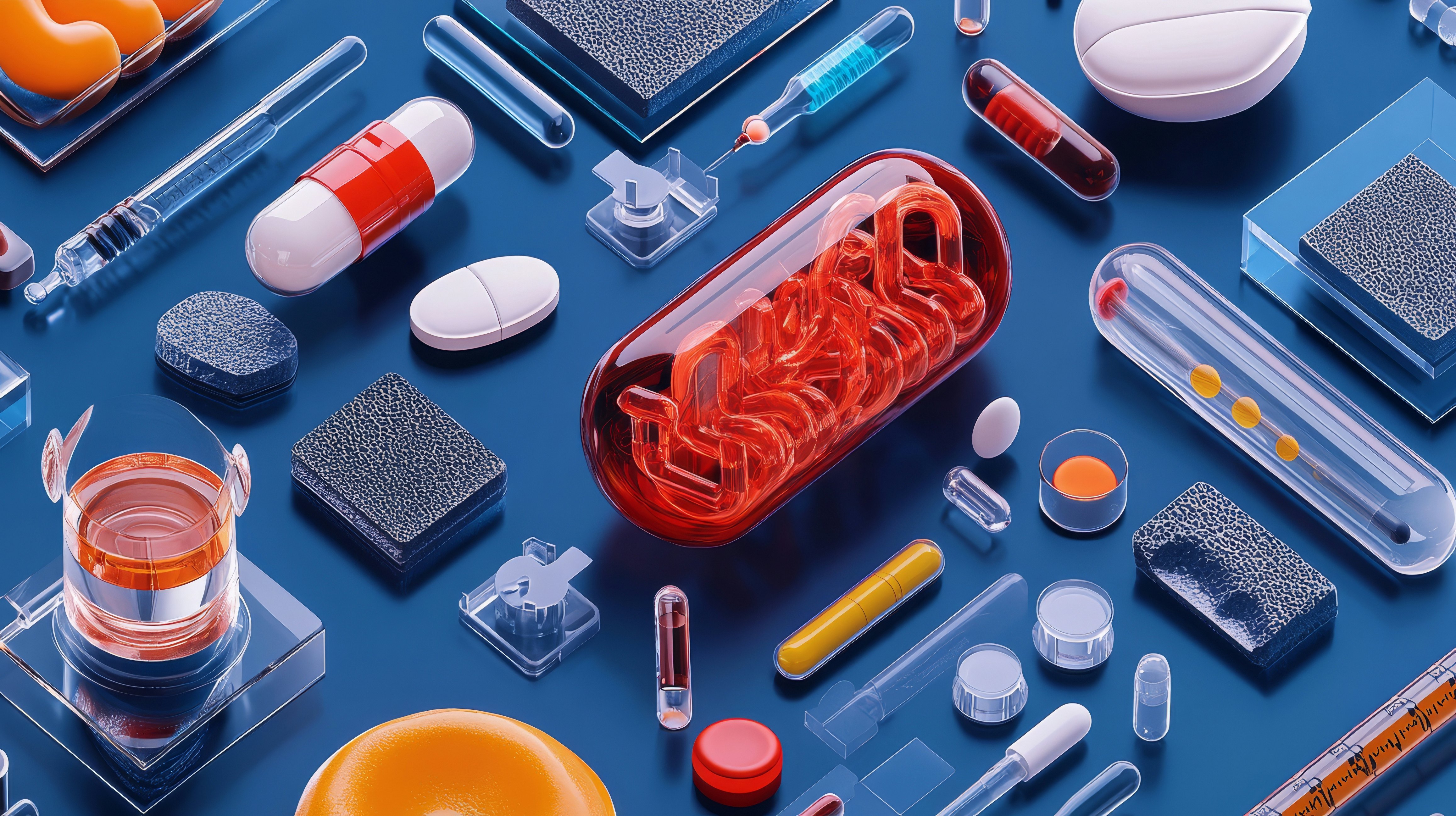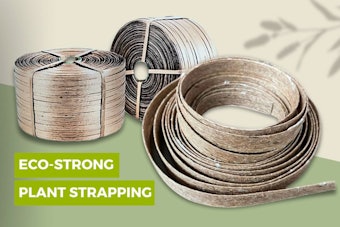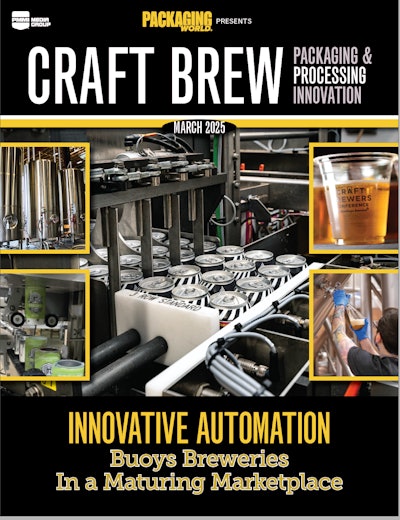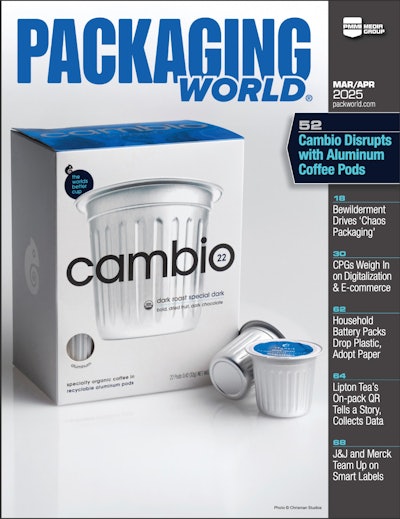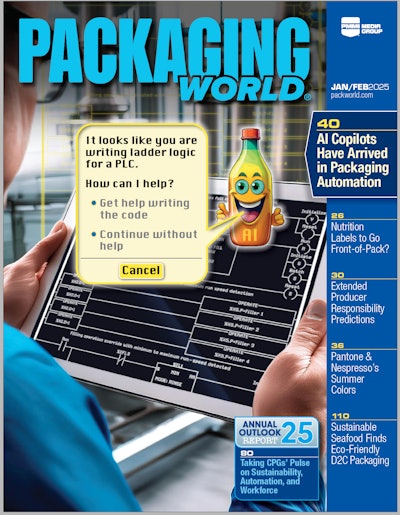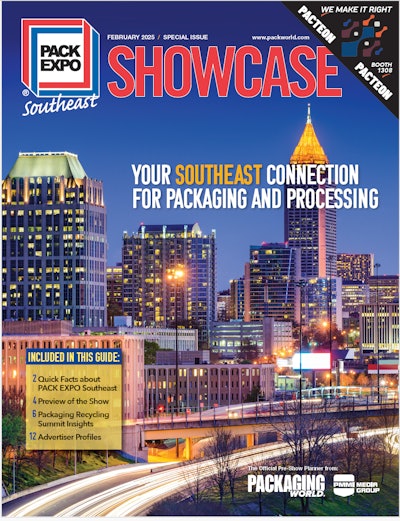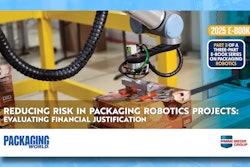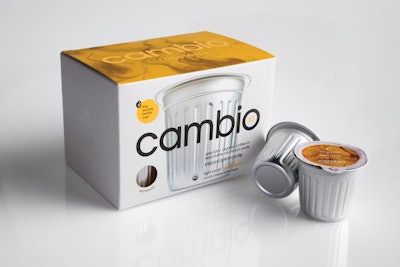
Cambio Roasters, a South Carolina-based coffee company co-founded by former Keurig Dr Pepper executive Kevin Hartley and partner Ann Hutson, is introducing the world’s first aluminum coffee pod compatible with Keurig brewers. The disruptive innovation comes at a time when consumer demand for products and packaging that offer greater sustainability are reshaping expectations in the single-serve coffee category. Cambio’s new aluminum K-Cups were developed through a multi-year project aimed at offering a scalable, recyclable alternative to plastic pods without compromising on performance or price.
 Kevin Hartley, co-founder and ‘chief evangelist,’ and Ann Hutson, co-founder and ‘customer advocate,’ Cambio Roasters
Kevin Hartley, co-founder and ‘chief evangelist,’ and Ann Hutson, co-founder and ‘customer advocate,’ Cambio Roasters
“About 40 million plastic coffee pods end up in landfills and oceans daily,” says CEO Hartley. “We believed it was time to introduce a fully recyclable solution that works just as well—or better—for the consumer and for the coffee.”
Mission-driven team reimagines the K-Cup
Cambio, which means “change” in Spanish, was founded with a dual mission: to reduce the environmental impact of single-use coffee packaging and to support struggling coffee-farming families by sharing 20% of its profits with those families. Hartley, who spent more than a decade scaling Keurig from a small Vermont startup to a market-dominating brand, saw the opportunity to apply that same disruptive spirit to fix the single-use plastic problem the original K-Cup helped create.
Hartley and Hutson founded the company in 2018. “When we started Cambio, we pulled together a dream team of former Keurig executives and packaging engineers,” says Hartley. “We wanted to redesign the K-Cup for the next 25 years—but this time with a triple-bottom-line focus: people, planet, and profit.”
Among those former Keurig staff recruited by Hartley were Rick Estabrook, Cambio’s “genius packaging engineer,” and Lindsey Bolger, who led Keurig’s global coffee sourcing and now oversees Cambio’s 100% organic, small-farm supply chain.
 | Read this related article, “KDP Unveils Plant-based, Compostable, Single-Serve Coffee Pod Concept” |
According to Hartley, Cambio was the one of the first K-Cup coffee brands to use 100% polypropylene, but the company’s end goal was a more transformative package—one that could be recycled at scale. The journey began in 2023 in what Hartley jokingly calls “garage lab” conditions in Shelburne, Vt. There, Estabrook and the team experimented with a range of prototypes.
Over the next couple of years, the company invested millions of dollars into R&D, working closely with a proprietary packaging supplier on pod design and materials and with its proprietary equipment manufacturer to develop a custom filling line. “Every K-Cup Cambio sells has been designed from the ground up with sustainability and usability in mind,” Hartley says. “This wasn’t a retrofit. It was a reimagination.”
And all of this had to be done without raising the retail price. “Our intent was to stay price-competitive with major brands like Green Mountain and Dunkin’,” Hartley says. “That’s how we make the biggest impact—by making better coffee pods accessible to millions.”
Replacing plastic while preserving quality
Switching to aluminum wasn’t just a sustainability play, though. Hartley also wanted to make a better cup of coffee. “If I hold up a plastic pod, you can almost see through it, they’ve been so lightweighted,” he says. “It’s too porous vis-à-vis oxygen. We say the oxygen transfer rate is too high, and so the coffee starts to degrade soon after it’s packed. Many coffee pods stay in the supply chain for a year on average. It’s not a sin, but the coffee just never again has the taste the roast master intended.”
He adds that aluminum is often referred to as the “magic metal,” both because it’s infinitely recyclable and because “coffee loves it,” he says. “The oxygen transfer rate is effectively zero. It’s impervious to oxygen, moisture, and light. So when you brew it, the coffee tastes exactly as the roast master intended.”
Cambio’s aluminum pod is a proprietary material structure that provides requisite brew-ability, barrier performance, shelf life, and recyclability for Cambio’s consumers.
 Cambio’s aluminum pod is a proprietary material structure that provides requisite brew-ability, barrier performance, shelf life, and recyclability. The pod’s ‘flavor ridges’ in the walls of the pod help extract maximum flavor from the coffee.
Cambio’s aluminum pod is a proprietary material structure that provides requisite brew-ability, barrier performance, shelf life, and recyclability. The pod’s ‘flavor ridges’ in the walls of the pod help extract maximum flavor from the coffee.
A carryover from Cambio’s plastic pod design are the “flavor ridges” in the walls of the pod that help extract maximum flavor from the coffee. “When water hits the coffee bed, the filter can press up against the pod wall, limiting extraction,” Hartley explains. “The flavor ridges hold the coffee filter away from the edge, so we get full extraction across the coffee bed.
“‘Coffee goodness’ is measured in total dissolved solids. We experience a significant increase in TDS with the flavor ridges.”
Also transferred from Cambio’s original pod design is its Easy Peel tab lid, an aluminum lidding film with a tab that enables the consumer to easily remove the lid from the pod for recycling.
A new machine for a new pod
For decades, Cambio’s equipment supplier has been producing custom packaging solutions. But when it came to the booming K-Cup market in the U.S., the company had remained on the sidelines, until the Cambio aluminum pods project opened the door.
When Cambio approached the supplier in early 2023, the pieces just fell into place. Cambio’s supplier had familiarity with small aluminum containers and understood the unique requirements for successful modified atmosphere filling, sealing, and handling.
While many consumers don’t realize it, virtually all coffee pods contain a paper filter inside. During brewing with a Keurig machine, a needle punctures the bottom of the pod; without a paper filter, the grinds would end up in the cup. The Cambio equipment places this filter into each pod as part of the process.
For the Cambio design, the team selected a coffee filter paper from among several supplier options, choosing one that best worked with Cambio aluminum pod and delivered the TDS and coffee flavor desired.
The first machine has gone through FAT and will begin production at a proprietary co-packer this spring.
Educating the market on recycling
When it comes to recycling, small-format packaging can be tricky to sort because it can slip through screens at the beginning of the sorting process at a material recovery facility (MRF). One way Cambio has tackled this issue is by designing the pods to nest or press together into larger units.
“We’ve worked with a recycling lab, and if you leave the K-Cup alone and drop it in, you can assume that somewhere between 60% and 90% will go through, according to the data,” explains Hartley. “And we say, if you press two together, then you are over the size constraints, and then the recyclability percentage is incredibly high. If you press three together, it’s even more so.
“So the pods are designed to press together and grow. And you could say, ‘Well, every consumer’s not going to do that.’ I get it. All we can do is say, ‘For best results and to help our planet goals, this is what you should do.’”
 | Read this related article on packaging design for coffee, “Coffee Brands Perk Up Packaging” |
Cambio’s secondary packaging includes step-by-step recycling instructions, and the Easy Peel tab makes disassembly intuitive—something Hartley says was lacking in traditional K-Cups. “Our research showed consumers hate digging into the puncture hole to remove the lid. It’s messy and unpleasant,” he notes. “We’re trying to remove barriers for consumers to recycle the pods.”
Another recycling option just announced in March is the Cambio Roasters Free Recycling Program, in partnership with recycler TerraCycle. Through the program, consumers can drop their spent Cambio pods in a box, download a prepaid shipping label, and send the pods to TerraCycle. The collected materials are cleaned, melted, and recycled into aluminum ingots that can be used to make new products, while the coffee grounds are industrially composted.
Hartley hopes these strategies are merely stopgap solutions until use of the aluminum pods reaches a scale that drives recyclers to develop a foolproof system to recover them.
An intentional, impactful packaging design
Cambio’s design approach has evolved along with its packaging. Originally, the company used molded fiber cartons, which were award-winning but costly and difficult to scale. Today, the secondary packaging is a sleek paperboard box that heroes the aluminum pod and communicates Cambio’s triple-bottom-line mission.
In designing the carton for the aluminum pods, Hartley shares that the goal was to make the packaging as intentional and impactful as the pod itself. “The brief to the packaging designer was, in the sea of greens and browns and oranges that dominate the coffee aisle, we wanted to do visually a mashup between Apple and Blue Bottle,” explains Hartley. “Apple with a passion for technology and sophisticated design, and Blue Bottle with a sophisticated design and the passion for coffee.”
The resulting carton design, led by Greg DiNoto and his studio in Brooklyn, leans into clean lines, minimalism, and a bold showcase of the aluminum pod. This is achieved through a larger-than-life image of the pod on the front panel, as well as a die-cut window that provides a view of one of the pods inside the carton.
“We wanted to hero aluminum on the front,” Hartley explains. “The communication objectives or the hierarchy we tried to do on the pack was first to the consumer—like, “Wow, check inside. That’s aluminum, are you kidding me?”
From there, the design invites the consumer deeper into the brand story. On the back of the pack is copy that details Cambio’s passion for coffee, which it calls “the worlds better cup.”
 A die-cut window in the coffee carton provides a view of one of the aluminum pods inside the carton.
A die-cut window in the coffee carton provides a view of one of the aluminum pods inside the carton.
“So first, the consumer sees that the pod is aluminum—that’s kind of cool,” says Hartley. “And then we talk about the best coffees in the world and the best coffees for the world.”
Inside the box, that storytelling continues, with a picture of Hartley and Hutson on the inside flap, along with the story of Cambio.
The design also includes unexpected touches to deepen the consumer’s experience, from inspirational quotes to custom insert cards that highlight the aroma of organic, specialty coffee brewing in what they call a Zero Compromise Pod.
“We just try to do as beautiful a thing as we physically can do with the constraints of reality,” Hartley says. “We literally think of it as business art—that each component could be gallery-able in MoMa.”
A strategy for scale—without the compromise
Despite the premium materials and engineering behind the pod, Cambio is positioning it at price parity with mainstream brands. “We expose ourselves to a higher cost of goods than any other K-Cup brand, but we do that intentionally,” says Hartley. “We didn’t want this to be a $10-per-pod product. We wanted scale. We wanted to make a real impact.”
As Hartley explains, Cambio’s target market is the environmentally conscious coffee pod lover—a mainstream Keurig user who values sustainability but also convenience and affordability. “According to Cambio’s proprietary research, about one-quarter of all Keurig® households are just waiting for something like this,” he says. “They don’t want to compromise on taste or price, but they’ll switch if you give them a reason.”
 Cambio coffee is available in eight blends, in 10-, 22- and 32-ct multipacks. The aluminum pods can be found in Walmart, Harris Teeter, Kroger, and Target.
Cambio coffee is available in eight blends, in 10-, 22- and 32-ct multipacks. The aluminum pods can be found in Walmart, Harris Teeter, Kroger, and Target.
Cambio coffee is available in eight blends, in 10-, 22- and 32-ct multipacks. The aluminum pods can be found in Walmart, Harris Teeter, Kroger, and Target. Consumers can also purchase the coffee from Cambio’s website and on Amazon, where sales have “blown up,” according to Hartley. “We haven’t been able to stay in stock for the last 90 days since we launched on Amazon,” he says. “It’s been crazy.”
Cambio’s intent is to scale up to 100 million pods as soon as possible, and the company is already speccing its second filling line.
“We’re not saying we’ve solved everything,” Hartley concludes. “But if we can shift even 10% of the market away from plastic, that’s billions of pods that won’t go to landfills or oceans. That’s worth doing.” PW



